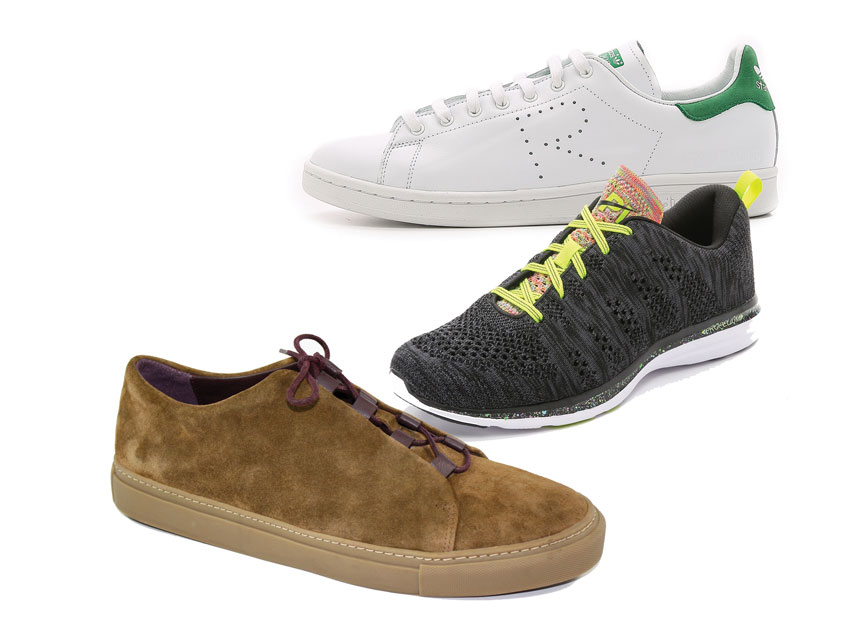SOLE SEARCHING: RETAILERS DISCUSS THE FOOTWEAR BUSINESS


Men’s footwear is having a moment. According to an April 2015 report by the National Shoe Retailers Association, men’s athletic shoes accounted for 20 percent of all footwear sales (men’s and women’s) during 2014, while men’s casual and dress shoes accounted for 9 and 6 percent, respectively.
“Men are becoming comfortable owning multiple pairs of shoes,” says Macy’s fashion director Durand Guion. “Sneakers have allowed luxury brands to access a broader consumer base. Men have had an overwhelming response to these elevated athleisure offerings as they are easier to work into an ever-changing lifestyle way of getting dressed. No longer are dress shoes the defining rule for weekdays and sneakers for weekends.”
Of course, the idea of men wearing sneakers for non-athletic purposes isn’t exactly new. “Find a picture of the back cover of the American country rock band New Riders of the Purple Sage’s first album from 1971, and look at what they are wearing: Adidas white tennis shoes and jeans,” says Glen Taylor, president of Taylor Richards & Conger, a specialty store in Charlotte, North Carolina. “While it was a counterculture concept then, it has become mainstream today. The modern look, as is seen in most fashion spreads, follows this lead and features sneakers as the shoe du jour. That said, comfort and practicality seem to resonate with a very large audience.”
Indeed, over the past couple of years, active influences have infiltrated all sectors of the men’s footwear market. There is a greater emphasis on sportiness and comfort, with new technologies being applied to shoe construction, specifically in the footbeds. Shoes of all sorts now have more support and also feature more active detailing.
“Trend and iconic designer motifs are driving the growth in fashion shoes whether it’s sneakers, boots or leather shoes. Think Fendi’s monster motif, Valentino’s camo print or Givenchy’s star,” says Saks’ vice president and fashion director Eric Jennings. “Sneakers will continue to grow and become a more significant portion of our designer assortments.”

This growing demand puts a certain pressure on designers and manufacturers who might have otherwise eschewed this category. “With technology removing the barriers between retailer and consumer, retailers know more than ever what their consumer wants,” says Emily Fine, accessories trend editor at trend forecasting agency Fashion Snoops.
Noah Waxman, known for his handmade leather dress shoes, recently started producing sneakers due to growing retail demand. “I did start to make sneakers because stores were asking for them,” says Waxman in his midtown Manhattan studio. “But I do them in a way that would remain true to the brand. Adding a sneaker allowed us to go to a lower opening price point, which is an easier place to do that rather than our leather dress shoes.”
Indeed, athleisure details are already making their way into all types of shoe styles for fall ‘16. Take Nike’s sneaker-boot for example. Part sneaker, part ankle boot, these sneaker boots are made of waxed leathers for weather resistance, and feature a sneaker-type midsole with a boot upper. For the guy who is not yet ready to give up the comfort of his sneaker, this new hybrid shoe features a more traditional leather upper on a rubber or crepe sole.
Even swimwear company Onia has branched out into hybrid footwear. Co-founders Carl Cunow and Nathan Romano merged the classic flip-flop rubber sole with Onia swim fabric, eyelets and draw cords to create a water-resistant, easy-to-wear shoe.
“The market has gotten so diverse,” says Jason Faustino, co-founder and creative director of NYC sneaker mecca Extra Butter. “Blogs and social media have helped brands understand what the consumer wants, and for the past two years, most of the major brands have been feeding the market exactly that. We’re at a fun time now.”
PHOTO CREDITS:
First Photo, top to bottom: Adidas x Raf Simons; APL, both courtesy of East Dane; Noah Waxman, courtesy photo
Second Photo, top to bottom: Want les Essentiels, Zespa, and Puma; all courtesy of East Dane





I am not a robot
Nice article obvious yes important to be said.
Footwear is a huge part of the menswear industry. The sneaker bottom has been happening now for over a decade and what’s going on we are using dressier uppers this way there’s two shoes and one.
On the bottom it’s made for comfort can be worn 24 hours a day the uppers has a dress style that will never end the shoe will become a companion for life .
“fashion fades but style remains”
Coco Chanel